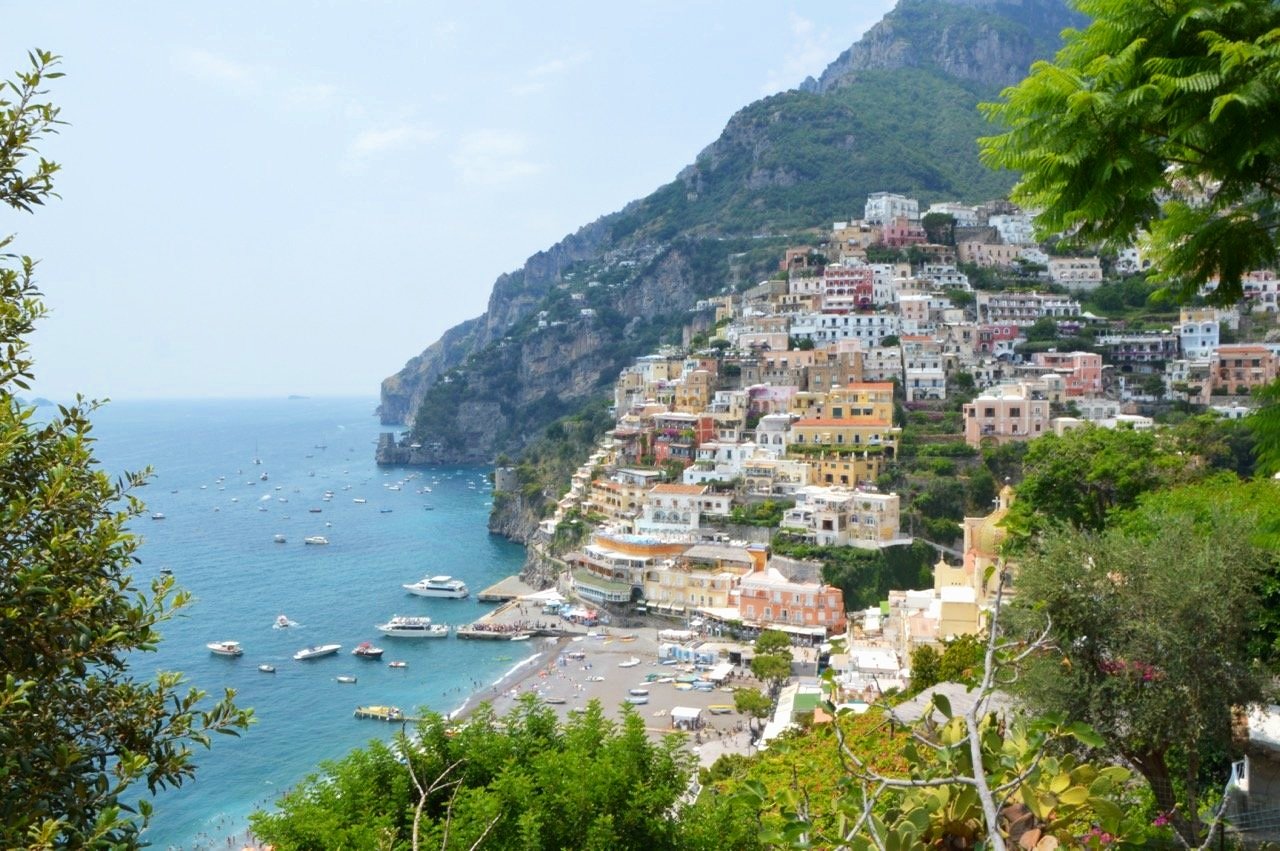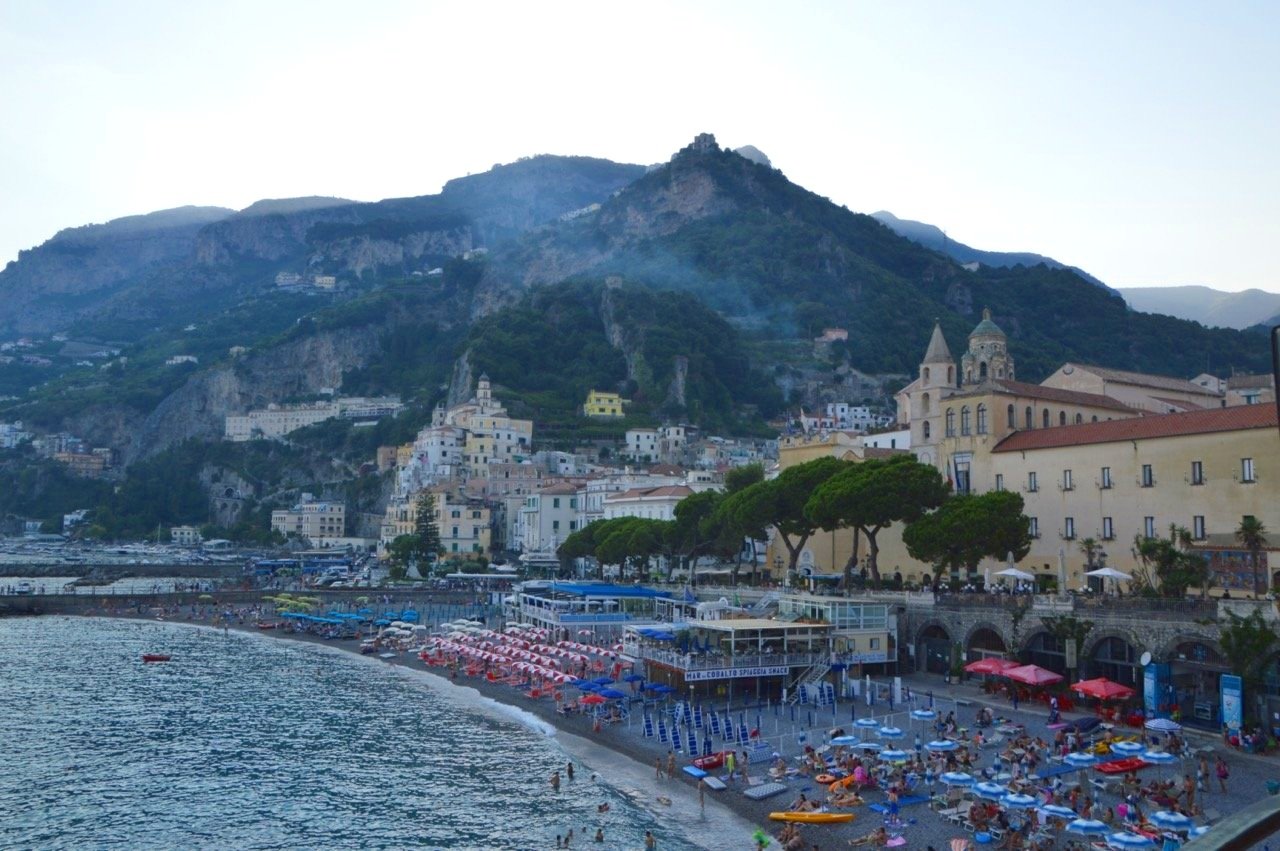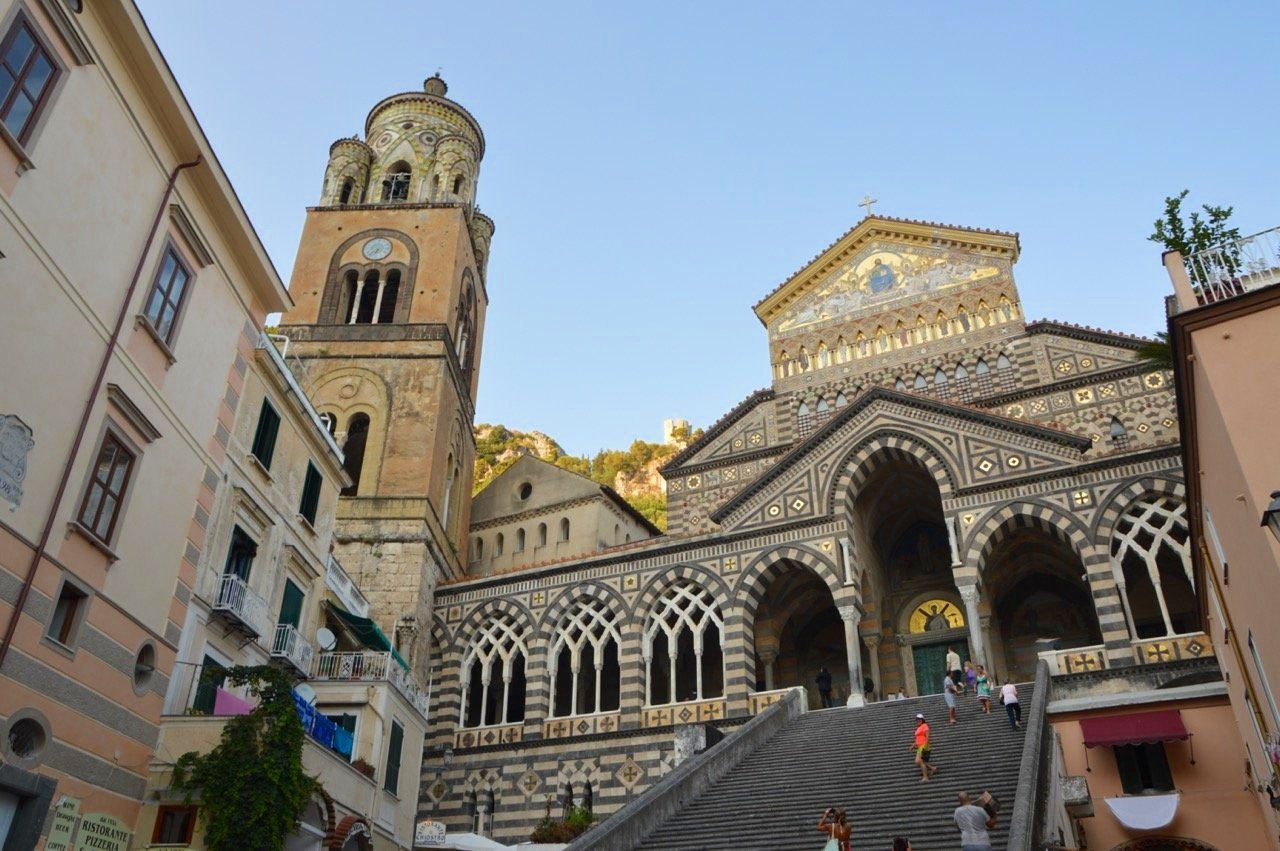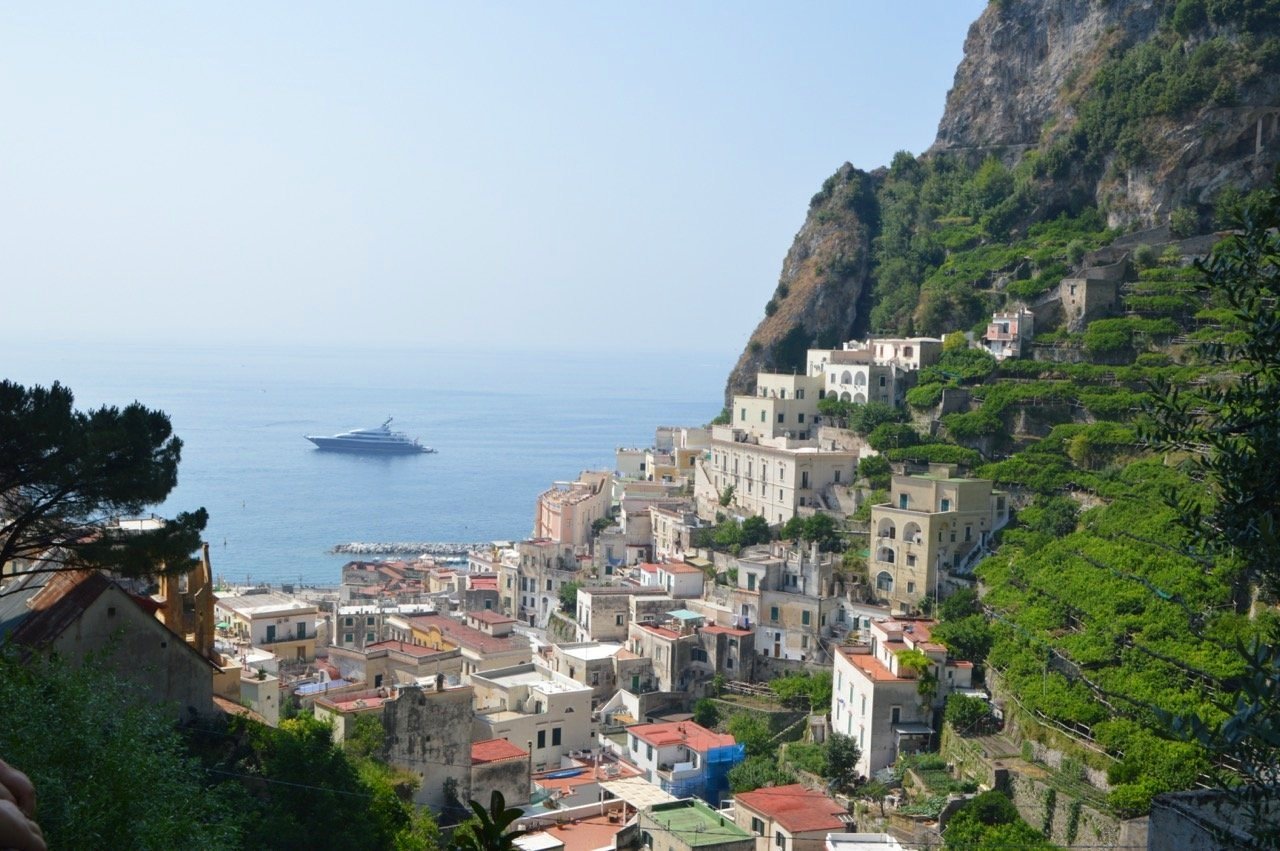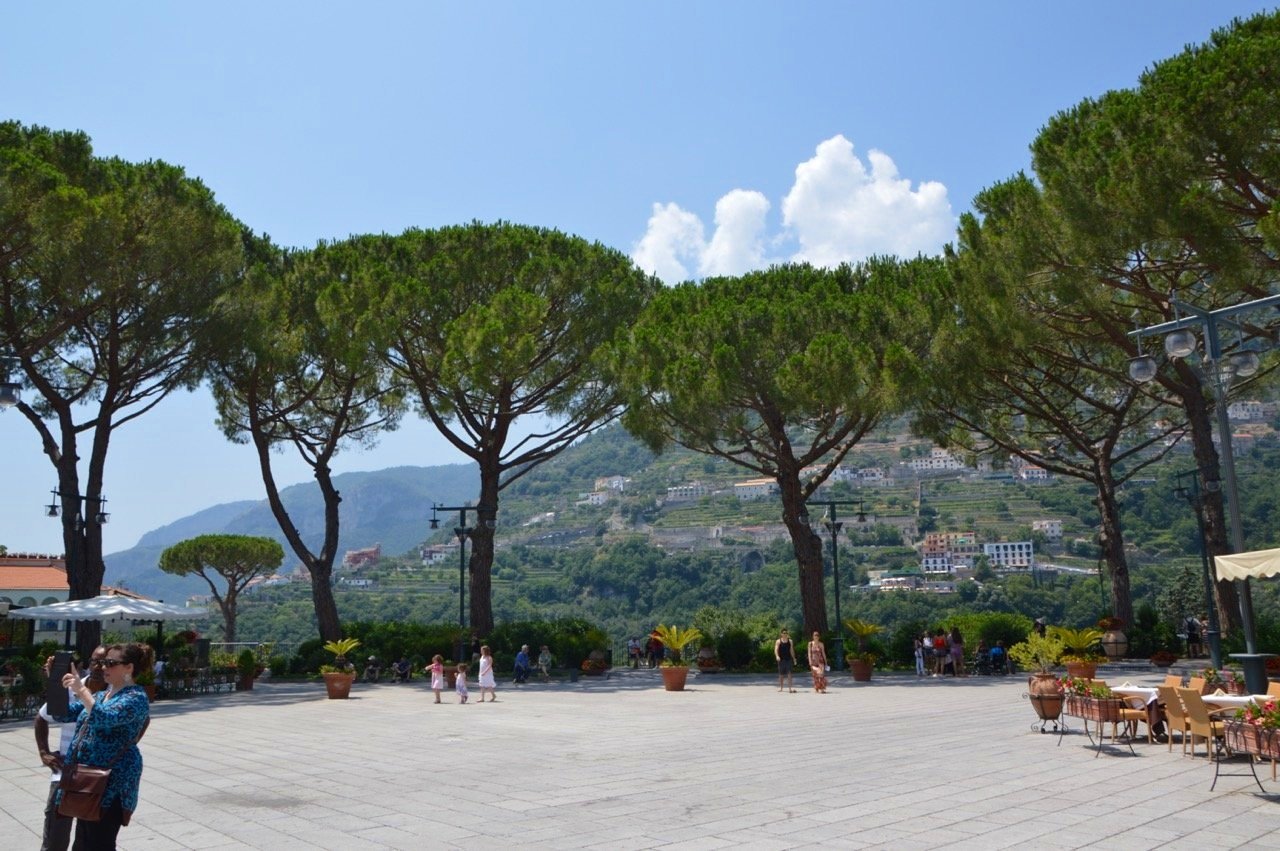The Perfect 7 Day Amalfi Coast Itinerary: One Week from Naples to Amalfi
Bri Mitchell shares her take on the perfect week-long Amalfi Coast itinerary, beginning in Naples and finishing in Ravello, just beyond the town of Amalfi. If you’re searching for a “catch-all” Italy itinerary that includes the best of coastlines, culture, history, food and sights, then you are in for a treat while exploring this enchanting region of Amalfi Coast Towns with this travel guide.
“The View” of the town of Positano along the Amalfi Coast.
Between Chris and I, we’ve spent a lot of time travelling, researching and exploring Italy. It can be really challenging to decide which region you want to explore when you come to this beautiful country, but in our time spent travelling there, we’ve definitely developed a few favourite areas.
I know for me, personally, it was hard to write The Classic 10 Day Italy Itinerary without including anything south of Rome in it. And further south, the 10 Days in Western Sicily presents even more incredible options to explore the beauty of the very south of Italy.
The truth about Italy, and really travel in so many parts of Europe in general, is that each region is so hyper-local and specific that you feel like you’ve travelled to hundreds of different countries by the time you leave.
When Chris and I were last in Italy, we started our trip by spending more time in the southern regions before heading north. We visited an Italian friend in Bologna later in the trip, and he was kind of shocked that not only had we visited the southern part of Italy, but we had survived it.
Southern Italy gets more than a bit of a bad wrap amongst northern Italians. Northern Italy is certainly beautiful, but there’s definitely an unfair stereotype about how unsavoury southern Italy is. That’s what encouraged me to write an Amalfi Coast itinerary, because although this region isn’t as southern as it gets, it’s definitely a region in Southern Italy to be celebrated.
This isn’t unique to Italy of course—there are regions in Spain, Germany, Switzerland, France, and on an on that don’t get their due or are regularly misunderstood.
Please note that this post contains some affiliate links. Simply put, this means that we may receive a small commission for our heartfelt and honest recommendations here at travelingmitch, at no additional cost to you.
A Little Background on the Amalfi Coast
Situated just south of Naples on the Tyrrhenian Sea, the Amalfi Coast is essentially located near the “ankle”, if you will, of Italy’s “boot”.
The history of the Amalfi Coast goes back to the ancient Romans, who inhabited the illustrious city of Pompeii and the surrounding areas for many years. Despite its impressive infrastructure and advanced society, nothing could have saved the 10 to 20 thousand citizens of Pompeii from the eruption of Mt. Vesuvius. In 79 AD, the volcano erupted and enveloped all of Pompeii, both eradicating and freezing all life in time.
In the modern day today, the “capital” of southern Italy, Naples, is only about 20km from the now historic site of Pompeii. From Naples to Pompeii to Amalfi and many places in between, the region is a hot bed of UNESCO World Heritage Sites that will be protected for years to come. While neither Pompeii nor Naples are technically part of the Amalfi Coast, they are both part of the gateway to the coast, and should naturally be the first stop on your trip.
Aside from its history, the Amalfi Coast is known for its picturesque seaside. Homes are seemingly carved into the rock faces of jutting cliffs, roads wind along the dramatic coastline, lemons grow in abundance everywhere, and it’s the birthplace of the Italian liqueur, Limoncello.
The charming town of Atrani is tucked away behind the dramatic cliffs of the coastline.
Where to Stay in the Amalfi Coast
There are a few different options for ways to stay on the Amalfi Coast. This article outlines the best approach to spend your time exploring the region over a 7-day Amalfi coast itinerary. If you are planning on hopping along the coast and staying at different places every couple nights, as I’ve outline below, then you should definitely do that. You will be charmed by all the different types of beautiful hotels along the coast.
That being said, if you are looking for a little more of a relaxed pace on your trip, and if you like the idea of having a home base, then finding a place to stay in Sorrento is recommended. Sorrento is a very charming town on the coast, but is a little bigger than some of its neighbours. Sorrento is accessible by train to Naples, and because it’s larger, it offers a wider variety of accommodation options, often times at more affordable prices than towns like Positano or Amalfi.
If you choose to stay in Sorrento during your itinerary on the Amalfi Coast, try to stay close to Piazza Tasso or near the city centre. There are some nice hotels up along Via Capo to the west of town, but it’s a pretty steep walk if you’re planning on coming in and out of town for meals, to freshen up during the day, or to meet boat tours at the water.
If you’re looking for an incredible luxury hotel during your trip, you can’t go wrong with a splurge at the Grand Hotel Excelsior Vittoria. It’s height boasts incredible views of the ocean and sunset from each of its water-facing rooms, and it feels like a true taste of European luxury on your holiday.
An excellent mid-range spot in the Piazzo Tasso area is Palazzo Jannuzzi Relais guest house. It is directly on Piazzo Tasso, and its front-facing rooms and balconies look over the bustling centre of the city.
A great budget-friendly accommodation in this area is Palazzo Tasso bed and breakfast. It is steps from the central piazza, with friendly staff and spacious, renovated rooms.
Meandering around the ruins of Pompeii. It’s a UNESCO World Heritage Site, as are many places along the Amalfi Coast.
How to Plan Your One Week Amalfi Coast Itinerary
The Amalfi Coast is a beautiful destination, but unlike other parts of Italy where many people come, snap a photo, and leave (this isn’t travelling, in my opinion, but I’ll save that for another blog post), this special coast in southern Italy encourages you to slow down your pace and relax a little.
Think about what matters to you on this trip—whether that’s food, beautiful accommodations or access to hikes, water, or historical sites. Really lean into whatever is calling you and let that be the focus that guides you during your time in this corner of the country.
Day 1: Naples
Naples is deserving of more than one day in its own right. It is one of the oldest cities in Europe, after all. But seeing as it’s the gateway to the Amalfi Coast, one day will suffice if you’re tight on time. Whether you are coming from the Naples airport, or taking a train from Rome, you will feel the excitement of Naples when you arrive.
Think of Naples like the gritty, rambunctious and bustling little sister to Rome. It’s a relatively comfortable city to walk around (keep an eye on your personal belongings, like in any major European city), and in a single day you can check out a few of the major sites.
During your brief time in Naples, consider visiting The National Archaelogical Museum in the downtown core. It’s very impressive and has a lot of artifacts from Pompeii and regional historical sites. It also has a wide array of marble sculptures, and will help you to understand the history of the region better before you explore.
If the weather is nice and you’re up for some walking with scenic viewpoints, start by wandering around Centro Storico (the historical centre of Naples). Take in the narrow, winding streets and alleyways. Save some time to explore the bars and street life in the afternoon and evening during your visit, too.
It’s also recommended to take the funicular up to the neighbourhood of San Martino. You can head to the Romantic Viewpoint, or walk around and take in the streets of this area. The Certosa e Museo di San Martino (cloisters and museum) is a former monastery that is now a museum overlooking the Bay of Naples and Mount Vesuvius. The history is extraordinary, as are the views.
Bear in mind that what Naples might lack in organization or neatness, it makes up for in flavour. Napolitanos are proud of the delicious dishes and street food for locals and tourists to enjoy. A classic dish to try is Neapolitan Pizza, or “Naples-style” pizza. This is the classic pizza that many have tried wordlwide, but being made with fresh local tomatoes and Buffalo mozzarella cheese in Naples, you have to actually eat this pizza while you’re here.
Impepata di Cozze is a dish of fresh mussels prepared with tomatoes, white wine, black pepper, and a dash of parsley. Spaghetti alla Puttanesca and all fried food served in a “cuoppo” (paper cone; think potato croquettes or friend pasta balls) are also well-known dishes to try.
These suggestions merely scratch the surface for all there is to see and do in Naples, but it’s enough to give you a taste and leaving you wishing you had a few extra days to explore.
Days 2-3: Sorrento & Pompeii or Capri
Views from the shores of Sorrento, the first of many seaside towns along the Amalfi Coast.
POMPEII
Depending on what type of activities you want to lean into, use the town of Sorrento as your jumping off point to either Pompeii, Capri, or both.
There are a variety of ways to get from Naples to Sorrento. We took the EAV Train on the Vesuviane line to both Pompeii and Sorrento. No trains travel through the Amalfi Coast, so the furthest you can get by train is Sorrento.
When Chris and I visited, we decided to go straight to Sorrento with our luggage to check into our accommodations and come back to visit Pompeii the next day. I wouldn’t say we made a mistake, since we knew we wanted to spend some extra time at Pompeii, but it is an option to stop off at Pompeii on your way to Sorrento to store your luggage in a locker, either at the train station at Pompeii or at the museum itself.
No luggage is allowed in the ruins of Pompeii, though, so the trick with leaving your bag is you need to aim to arrive earlier in the day. If you arrive later in the day and the luggage lockers are all full, you’ll be left with nowhere to store your bags during your visit to the archaeological site.
Regardless of whether you visit Pompeii on your way to Sorrento, or if you double back to see it like we did, Pompeii is not to be missed. Not only is the history of this ancient city very interesting, but the way the volcano exploded and eradicated the city so quickly is astonishing. It allowed so many human remains and personal belongings to be remain completely intact until excavation.
Make sure you keep in mind that Pompeii itself is an old, fairly large city, so a day exploring Pompeii involves a lot of walking on uneven terrain. If you or someone you’re travelling with has a physical disability or challenge walking, this is an important thing to keep in mind.
Some highlights to check out while you’re exploring the ruins of Pompeii are The Temple of Apollo, The House of the Vettii, The House of the Faun and the Ampitheatre. These sites are all very neat to explore, but nothing felt as haunting and memorable as seeing The Plaster Casts of the people of Pompeii on the day of the explosion.
Another addition to your trip to Pompeii might be a Rick Steves audio guide (Chris knows Rick, by the way, and interviewed him). He has put together some fantastic guides (complete with maps) for a few key European sites and cities. Chris and I used his audio guide and the map during our visit to Pompeii and found them so useful and educational.
I don’t consider myself a history buff, or even a history nerd, but finding very detailed mosaic tiles in the elaborate courtyards of the elite from 50 AD was very cool. Seeing restaurant storefronts with preserved artwork for “chicken” or “beef” remaining intact all these years later is a bit mind boggling. Coming across all of these artifacts preserved under the shadow of Mount Vesuvius as it still stands is a very humbling experience. I highly recommend it.
Chris at the Ampitheatre of the Ruins of Pompeii.
SORRENTO
Sorrento itself is the main “hub” of the Amalfi Coast because it’s the first of the scenic town along the iconic coastline. For me, The Amalfi Coast, including Sorrento, is less about visiting specific sites and more about wandering around and taking in the first of these picturesque towns along the dramatic hills of the coast.
Chris and I really enjoyed kind of losing ourselves along the steep hills and winding roads of Sorrento. Piazza Tasso is a scenic central square, lined with cafes. Some hotels and cafes on the perimeter also look out to the ocean. When you first arrive in town, this is a good place for to start exploring town.
Marina Grande is another great place to mosey down to. It’s the quieter of the two marinas in Sorrento, and if you’re leaving on a day tour by boat (which many people do), then you’ll likely be departing from this marina or Marina Piccola (also very scenic).
There’s a small public beach at Marina Grande where Chris and I decided to go swimming on a hot day, which was a little busy, but considering how crammed the Amalfi Coast is in general, it was really pleasant. There are also private beaches you can visit. We’d also been travelling for a few weeks at that point and hadn’t gone swimming yet. One of my non-negotiables when we travel is that if we’re travelling near water, we need to swim at least once. So it was a necessary choice.
Another great place to wander while you’re taking in the sites of Sorrento is Corso Italia, roughly between Piazza Tasso and Parco di Villa Fiorentino. This stretch of road is charming and has many shops and tourist attractions. Chris and I also found ourselves making some late night friends at Chaplin’s Irish Bar before heading back to our hotel for the night.
Boating is a popular activity along the Amalfi Coast in Italy.
BOAT TOUR TO CAPRI
While the destinations along the mainland of the Amalfi Coast are a hot topic, many people like to get out on a boat for at least one of the days during their trip and visit Capri. If you don’t plan on visiting Pompeii or Capri during your time in Sorrento, then I think you only need one day in Sorrento. It sounds short, but considering how scenic the Amalfi Coast is, this would be my recommendation.
If you do plan on taking a trip to Capri, know that it will take up the better part of a full day. You can take a boat tour to Capri from other towns along the coast if you’d like, but I think Sorrento is a nice place to take the trip from because it’s a higher-trafficked place.
Make sure you do some research to determine a good tour provider online. If you aren’t travelling during the busy season (especially July and August), you can also walk down to Marina Piccola early in the morning to see if there are any companies with some last minute tickets for a tour. You might be out of luck if you do it this way, but if time is on your side and you’re flexible, it’s possible you could get a deal.
It would be wise to find a tour that makes a few stops around Capri, like at The Blue Grotto, which is a famous sea cave along the coast. Faraglioni is also a stop on some tours, which is an arch in the rocks off the coast of Capri. A legend says that if you kiss your partner while passing through the hole in the rock, you will be together for eternity.
Some other points of interest on a trip to Capri are Villa San Michele, a house famous for its interior architecture and stunning gardens. Monte Solaro Anacapri is the second largest area of the island, with access to Mount Solaro and views from the top. And the final stop on most tours is Piazza Umberto, which is the main square of Capri.
Classic views on the walk along the coastal road from Praiano to Positano.
Days 4-5: POSITANO & PRAIANO
To get from Sorrento to Positano and Praiano, you have the option of taking a ferry, a bus or private transfer. For the budget-friendly traveller, one of the travel tips I’d recommend is to take the local bus because it’s more reliable (ferries can be cancelled sometimes due to bad weather), and the bus will drop you off along the main highway that passes through the towns.
If you take the ferry, while it will be scenic, you’ll be dropped off at the water. This means that you’ll more than likely be met with several steep steps or roads standing between you and your accommodations.
Another good reason to take the bus is if you plan on using this “hack” to book your accommodation, the bus will take you beyond the bounds of Positano. Enter the hack: Chris and I visited the Amalfi Coast in July (it was the only time we had to spend over a month in Italy), which is also arguably one of the busiest times of year for tourism.
Not only did we find it challenging to find available accommodations as we were booking and planning on-the-fly, but we also found that accommodations in the “hottest” towns along the coast were far more expensive than neighboring towns. This is why we opted to book a scenic hotel in Praiano while we were in the region of Positano.
Praiano has a few of its own beautiful sights to check out, like the Church of San Gennaro and Marina di Praia Beach. It also has a stunning seaside of its own, and staying in Praiano instead of Positano was great for these three reasons:
Firstly, it was way more quiet at the end of the day. Since there’s such a concentration of travellers in Positano at night, it can be less quiet and relaxing in the evening. We ended up booking a room at a charming hotel on the coast that had stunning seaside views and even had a little lemon tree on our balcony. It was locally owned, and it showed.
Secondly, Chris and I love to get our steps in while we’re travelling. Staying in Praiano allowed us to walk along the coastal highway to Positano and back again during the day. Not everyone would like this, but we really enjoyed it. With the exception of the occasional driver going quickly around hairpin turns, it was a nice walk.
Thirdly, walking towards Positano allowed us to take in that breathtaking view of it from several vantage points at a distance. I’d have to say that the walk to Positano was almost as memorable as being in it was, simply because around each turn of the coastal road, we saw it from a new point of view.
Bri taking in the views on the walk to Positano from Praiano. They can’t really be done justice on a camera. You’ll have to see them for yourself.
Once you’re in the magic of Positano, whether it’s where you’re staying or where you’re spending time for the day, there are a few key points of interest to check out. First of all, whether you’re walking from Praiano or not, the view of Positano from the road coming in to town is very special. Anywhere about 2km east of Positano on Amalfi Drive (the main road) has a great view.
Next, while you’re in town, think about what you want to explore while you’re there. The winding and narrow streets of Positano are perfect for wandering. Start by taking Via Cristoforo Colombo into town, and stop at viewpoints and scenic shops along the way. Then wander down Piazza di Mulini towards the water. This will lead you through the winding pedestrian streets, which are the most fun to explore.
Make sure you visit at least the outside of Chiesa di Santa Maria Assunta, the main church by the water in town. Churches like this shed some light on just how precisely these buildings have been built on the water, and the entrance area is on a larger platform in the heart of town.
Aside from wandering the streets, many tourists like to spend time on one of the beach chairs on Spiaggia di Positano (the public beach). It’s a nice sandy/stoney beach, with great access to the ocean. It also has beautiful views of the stacked buildings of Positano from above. A little away from the centre of things is the quieter and smaller Fornillo Beach, which is slightly west of the centre of town. Many people also take a boat tour out of Positano along the coast from here.
Restaurants are in competition in Positano, and can be quite busy. There are too many great restaurants to list here, but I’d highly recommend choosing a restaurant with a patio looking over town, or a little distance from town. Chris and I stopped at a restaurant at the top of Via Cristoforo Colombo with beautiful views of Positano from the balcony.
If you haven’t noticed—just admiring this small town was my favourite thing to do while we were here. “The view” of Positano from a distance is arguably the most famous view in all of the Amalfi Coast. Make sure you take some time to take it in on your trip, too.
DAYS 6-7: AMALFI, ATRANI & RAVELLO
This last stretch of your Amalfi Coast trip is sure to leave you feeling so glad you visited this beautiful region.
Similarly to when Chris and I stayed in Praiano, we decided to stay in the neighbouring local town of Atrani during our time spent a little further along the coast, near Amalfi.
Atrani in itself is another very scenic town, tucked into the deep valleys of the astonishing cliffs of the coast. As you explore more of these coastal towns, you’ll quickly find that each town is developed in a very similar way. All central pedestrian roads lead to the main church, and there are excellent little walkways to venture through and get lost in on each visit.
The walk to Amalfi from Atrani has a few pedestrian and car tunnels, which shows you just how carefully these towns needed to plan to build their coastal road. In Amalfi town (above, left), Piazza Duomo is the central square with iconic views of the church and its tall steps (above, right). There’s also a long shopping street called Ruga Nova Mercatorum (Via dei Mercanti), which is a great place to take a stroll while you’re in town. As with every town along the coast, it’s also nice to walk along the port to take in all the sites from the water.
On our second day staying in Atrani, Chris and I decided to hike up to the town of Ravello for a day trip. There are ways to take buses or private transport to this famous town, but we were staying in a guesthouse in Atrani with a hiking path directly behind it, so we figured, why not?
We were grateful for the exercise, because in these small towns it can sometimes be tricky to get all your steps in, but be forewarned, the hike is steep. In about 45 minutes (entirely uphill, views pictured above, left), we got to Ravello definitely needing to refill our water bottles. We were so grateful to be rewarded with the beautiful views of this town when we got to the top.
Ravello’s history dates back to around the 5th Century AD, and was created as a place of refuge from the barbarian invasions during the fall of the Roman Empire. In recent centuries, it’s been a place of refuge for different reasons. Many artists and writers have flocked to it, including Greta Garbo and André Gide.
There are several beautiful sites to take in around town. Start at the Piazza Centrale / Piazzao Duomo (pictured above, right—where else would you start in an Amalfi Coastal town?), and grab a cup of coffee or something small in the town square. On the day we visited, local musicians were playing and people were dancing in the square. It felt a bit like we were in some sort of romantic Italian movie, which I had no complaints about after the steep hike.
From the central square, meander around the streets of Ravello. Do your best to stop at Villa Rufolo—a Moorish-style villa from the 1200’s with gorgeous views of the ocean from its grounds. Another great place to take in stunning gardens and great views is Villa Cimbrone Gardens.
There are many great restaurants and cafes in Ravello, but the real attraction of either staying overnight or visiting this town is to take a step back and breathe in that fresh sea-view air before the end of your Amalfi Coast trip.
Dusk falls over the Amalfi Coast in the town of Praiano.
Remember to Leave Time For You in Your 1 Week Amalfi Coast Itinerary
As a long-time traveller and at times, admittedly, a planner, I understand the desire to have a plan when you’re on the road. The fall-out of the best laid plans, however, is that sometimes the focus of the trip falls too much on the destination, and less on your experience in that destination.
If you must plan one thing on this trip, book your accommodation in advance. Pick something budget-friendly and beautiful, because often times the accommodations on the Amalfi Coast speak as loudly as the towns themselves.
Remember that you must leave some time for you on this trip. I think of our trip to the Amalfi Coast as one of the most special that Chris and I have taken, and I can attribute a lot of that to the fact that Chris and I didn’t over plan. We merely wandered and enjoyed our time exploring the Amalfi Coast.
Have an extra Aperol Spritz on that terrace overlooking the ocean. Taste the third gelato of the day, because you’ll need to compare this gellateria’s lemon gelato to the last one. Spend a few extra minutes on your hotel balcony admiring the sunset over the calming ocean, or watching the full moon rise over the soothing darkness of the Tyrrhenian Sea.
Whatever you need to do during your time in the Amalfi Coast, listen to your body and mind when they tell you to slow down take a beat. Because you’ll never get another moment of solace or a feeling of introspection in quite the same way as you will when you visit this memorable corner of Italy.
If you appreciated this article, you’ll love our newsletter, as well as our Facebook group! Feel free to join, all are welcome.
Bri Mitchell
Bri Mitchell is a travel writer and content creator from Toronto, Ontario. She loves to highlight all things nature, food, wellness, sustainability and adventure in her work. Bri writes and shares her travel experiences from across Canada, the United States and around the world on Instagram and TikTok (@brimitchelltravels), and in her articles for travelingmitch, Ultimate Ontario, and We Explore Canada.

